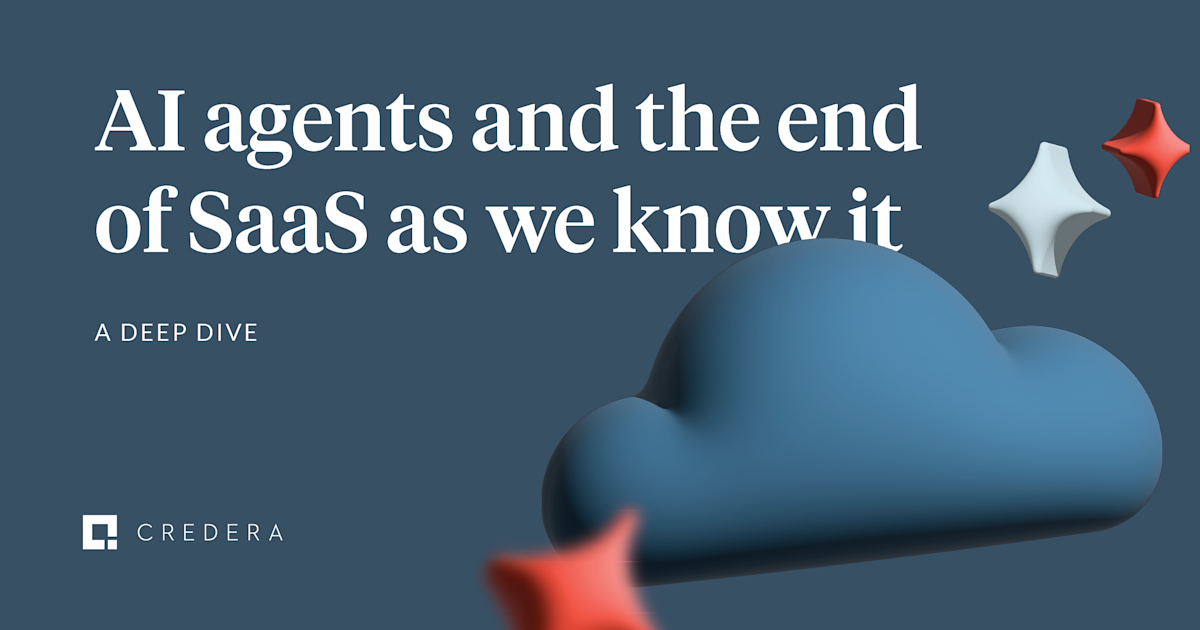
2025 is set to be the year of AI Agents (again!). As we settle into the new year, the conversation around AI agents is accelerating at an unprecedented rate. Both the Public and Private sector are no longer just speculating but actively exploring the large-scale deployment of AI agents in critical business and data management operations.
One of the most shared examples of this shift is the recent interview with Satya Nadella, CEO of Microsoft, on the BG2 podcast. In the interview, Nadella made the optimistic - and to some, provocative - statement that traditional business apps will soon be replaced by AI agents and the MarTech landscape will essentially transform into an AI dominion.
According to Nadella, business applications are essentially create, read, update and delete (CRUD) databases with a bunch of business logic (or rules) that will soon be managed by AI agents acting as vendor-agnostic, multi-repo CRUD orchestrators. For those familiar with the concept of agentic AI and basic data management principles, this progression may sound logical, even exciting (if this is the kind of thing that excites you). However, as is often the case with grand AI statements, it oversimplifies the complexity of building the foundational infrastructure required for AI agents to operate effectively.
Let’s dig under the hood...
At their core, most Software-as-a-Service (SaaS) applications are sophisticated tools designed to store and manage information. To simplify their function, SaaS applications perform four essential actions: creating, reading, updating, and deleting data, commonly referred to as CRUD. Traditionally, these operations are complemented by hardcoded business logic - specific rules and workflows that dictate how data is processed. This combination defines the functionality of individual applications.

Traditional CRUD applicaton model
However, the integration-centric nature of modern enterprise systems is reshaping expectations. Cross-platform data access and shared business processes have become table stakes, setting the stage for a deeper, AI-driven evolution in how SaaS applications function. AI will fundamentally alter what integration looks like, with layers of intelligence that disrupt and subsume traditional SaaS models into a more unified environment.
Enter AI agents
Agentic AI refers to systems capable of independent decision-making, adapting dynamically to changing inputs and goals. AI agents, on the other hand, are specialised implementations of agentic systems designed to perform tasks autonomously within specific contexts. They often interact with other software systems through APIs or user-level actions, bridging the gap between deterministic programming and adaptive functionality.
In the SaaS context, AI agents can:
Automate workflows by dynamically orchestrating data flows and task execution across applications.
Enhance decision-making by leveraging real-time data and predictive analytics to suggest optimal outcomes.
Adapt business processes by learning from patterns and improving operational efficiency over time.
SaaS evolution: A brief history
The SaaS industry’s foundational backend systems are built on rigid business logic - a set of rules defined by developers to govern software behaviour. This model worked well in a predictable environment but struggled to adapt to rapidly changing user needs and integration challenges. As the market evolved, tools like Integration-Platform-as-a-Service (iPaaS) emerged to address the growing complexity of interconnected tech stacks, enabling enterprises to integrate and automate across platforms.
However, iPaaS tools, while powerful, are inherently rule-based. They require human designers to craft workflows and specify integration rules. The introduction of AI agents represents a significant leap forward, offering adaptability and intelligence that rule-based systems cannot match.
A match made in Silicon Valley
This is why Satya Nadella and the rest of the tech world hold such optimistic views about the rapid shift toward AI agents replacing SaaS business logic. AI agents could in theory replace the CRUD rules layer that makes SaaS application function.
Unlike traditional back-end systems that follow pre-set rules, AI agents should be able to adapt and act dynamically by analysing real-time data and autonomously decide which processes and actions to initiate, optimise, or terminate.

Traditional SaaS model with AI agent overlay (topline view)

Traditional SaaS model with AI agent overlay (drill down)
Furthermore, being autonomous and intuitive, AI agents should be able to simplify the integration of disparate systems by learning the nuances of API interactions and user workflows, reducing the need for manual configuration. Operating with objectives in mind, AI agents could adapt their behaviour to achieve specified outcomes, which would mark a much-needed departure from the static workflows of traditional SaaS. Moreover, by identifying and correcting errors autonomously, these agents would have the ability to enhance the resilience of SaaS platforms, creating self-healing systems that reduce downtime and manual oversight.
That's a lot of shoulds, coulds, and woulds - the question is will AI agents be able to autonomously and successfully replace back-end business rules to achieve set objectives? And if so – how and how soon?
The future is here (-ish)
The short answer is yes – to an extent.
While AI agents have immense potential, the question of whether they will replace the back-end business logic layer is nuanced and depends on many different factors.
First of all, scalability is paramount - AI agents must prove they can effectively manage complex, dynamic processes that traditional systems struggle with, such as rerouting workflows during outages autonomously. Interpretability will also play a crucial role, as traditional logic systems are explicit and easily auditable - a significant advantage for compliance-heavy industries. AI agents, which often operate as black boxes, must address transparency and governance challenges to gain widespread trust.
Cost considerations cannot be overlooked, as deploying AI agents may be initially expensive compared to maintaining rule-based systems. However, their potential to significantly reduce manual oversight and increase efficiency could justify these investments.
Ultimately, the path forward is most likely to be a blend of both human-led and agentic processes and systems, where AI agents augment rather than replace back-end logic entirely. Critical processes may still rely on pre-defined, human built, deterministic rules, while AI agents handle adaptive, flexible tasks, creating a more balanced and resilient system.
So how can you prepare?
So far one thing is clear - AI is progressing more rapidly than many organisations can adapt. The positive, however, is that the principles of building strong foundations remain fairly unchanged:
Document processes thoroughly: Establish clear, well-documented workflows to lay the groundwork for integrating AI solutions and ensuring smooth transitions.
Modernise infrastructure: Upgrade to scalable, flexible systems that support AI-driven transformations while maintaining performance and reliability.
Plan for incremental transformation: Adopt a phased approach to implementing AI, setting realistic goals and metrics that allow for controlled expansion and measurable success.
Ensure quality, structured data: Implement robust data governance and validation processes to maintain accurate, consistent information essential for effective AI-driven insights.
Review consent, privacy, and AI ethics policies: Regularly evaluate compliance with data protection regulations and ethical frameworks, ensuring responsible AI usage and user trust.
Invest in AI upskilling and change management programmes: Develop training programmes, allocate resources for AI-focused initiatives, and cultivate a culture that embraces continual learning and technology adoption.
These principles might sound common-sense but are in fact the foundational focus of all our conversations with organisations seeking to scale AI solutions or deploy agentic capabilities. The challenges our clients experience on their AI journey are very similar to the ones we have been helping them overcome as part of traditional MarTech transformation – overcoming legacy data silos, ensuring streamlined infrastructure, implementing robust governance structures, and deploying change in a user-centric manner.
Even revolutionising the future can only be achieved once the same old tried-and-true foundations have been established. These foundations ensure that we can implement strategies for navigating the complexities of transformation while helping organisations remain agile and competitive in a rapidly evolving landscape.
What this means for the future of SaaS
Agentic AI and AI agents represent a paradigm shift for SaaS applications, pushing the boundaries of automation, integration, and intelligence. While they may not entirely replace the back-end business logic layer, their potential to augment and transform it is tricky to overlook.
The future of SaaS is not a question of AI agents versus traditional systems but rather how these technologies can coexist and complement each other to create smarter, more responsive platforms.
As businesses contemplate this evolution, the immediate next steps might still be murky, but leaders must begin by assessing their current systems and identifying areas where AI agents can have the most immediate impact. This means prioritising the documentation of workflows, upgrading infrastructure, and ensuring robust data governance practices are in place.
Equally important is building a strong governance framework and fostering talent ready and confident to collaborate with AI tools. By approaching this transformation incrementally, organisations can position themselves to harness the full potential of AI agents while mitigating risks and challenges. The era of AI agents is not just an opportunity - it's an imperative for those aiming to stay competitive in today’s digital landscape.
How Credera can help
At Credera, we understand the complexity of adopting and integrating AI in ways that drive tangible value. With over 20 years of experience delivering advanced data and AI solutions in highly regulated industries such as financial services, healthcare, and the UK public sector, we are uniquely positioned to help organisations navigate this era of change.
Our expertise spans all areas of AI industrialisation – from infrastructure planning to solution deployment and business transformation, ensuring that businesses can harness the opportunities of AI while addressing regulatory, ethical, and operational challenges. If you are an organisation looking to get ahead in this new landscape, contact us to discuss how we can support you on this journey.
Contact Us
Let's talk!
We're ready to help turn your biggest challenges into your biggest advantages.
Searching for a new career?
View job openings


